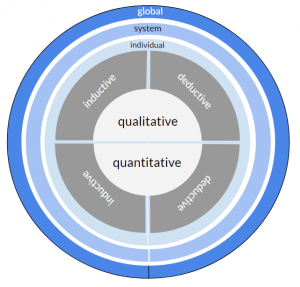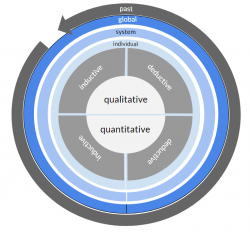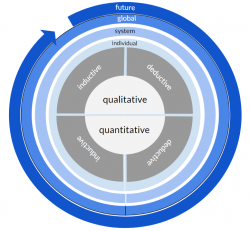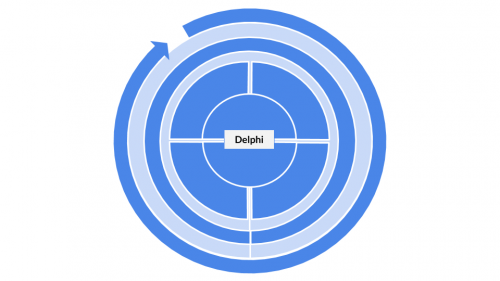Difference between revisions of "Sustainability Methods:About"
| Line 11: | Line 11: | ||
=== Ontology === | === Ontology === | ||
At the core of the Wiki stands the Ontology of Scientific Methods. If you want to read more about the idea behind it, please refer to the [[Ontology]] entry. In short, the idea is to challenge the prevalent assumption that each scientific discipline must be restricted to narrow set of scientific methods. Instead, the Wiki suggests that methods should be selected according to the intended type of created knowledge. To show that methods are not bound to disciplines, '''the Wiki categorizes every major scientific method in Sustainability Science using four different criteria:''' | At the core of the Wiki stands the Ontology of Scientific Methods. If you want to read more about the idea behind it, please refer to the [[Ontology]] entry. In short, the idea is to challenge the prevalent assumption that each scientific discipline must be restricted to narrow set of scientific methods. Instead, the Wiki suggests that methods should be selected according to the intended type of created knowledge. To show that methods are not bound to disciplines, '''the Wiki categorizes every major scientific method in Sustainability Science using four different criteria:''' | ||
| − | |||
<br/> | <br/> | ||
* [[:Category:Quantitative|Quantitative]] - [[:Category:Qualitative|Qualitative]] | * [[:Category:Quantitative|Quantitative]] - [[:Category:Qualitative|Qualitative]] | ||
| Line 19: | Line 18: | ||
<br/> | <br/> | ||
You can click on each category for more information and all the entries that belong to this category. | You can click on each category for more information and all the entries that belong to this category. | ||
| − | + | <br/> | |
Each method fulfills one or more categories per criterion. To highlight this, each method entry includes a visualisation of the method's categorization. The general visualisation is designed as follows: | Each method fulfills one or more categories per criterion. To highlight this, each method entry includes a visualisation of the method's categorization. The general visualisation is designed as follows: | ||
| Line 26: | Line 25: | ||
The temporal scale is added through a fourth layer of concentric circles: | The temporal scale is added through a fourth layer of concentric circles: | ||
This visualisation refers to the majority of methods that focus on a slice of time - the present. | This visualisation refers to the majority of methods that focus on a slice of time - the present. | ||
| − | + | <br><br><br><br> | |
[[File:ConceptPast.png|250px|left|The Method Categorization Concept for Past Methods]] | [[File:ConceptPast.png|250px|left|The Method Categorization Concept for Past Methods]] | ||
| Line 39: | Line 38: | ||
[[File:ConceptDelphi.png|500px|center|The categorization for the Delphi method]] | [[File:ConceptDelphi.png|500px|center|The categorization for the Delphi method]] | ||
| + | |||
| + | The categorization may serve as a guide to understand how methods are connected and to select methods for one's own research. Every reader may browse through the presented methods and learn about methods that never seemed fitting for one's own research, but maybe are. | ||
Revision as of 14:53, 2 September 2020
About this wiki
The aim of the Sustainability Methods Wiki is to present and explain fundamental methods, terms and tools relevant to (Sustainability) Science and answer underlying questions. It shall serve as a resource for students, researchers, teachers and any interested readers that wish to broaden their knowledge in terms of scientific methods and tools and engage with new perspectives on science. The Wiki challenges the Status Quo in scientific methodology and raises questions concerning the nature of scientific methodology.
The Wiki is divided in four different sub-wikis:
- Courses, which includes supplementary texts to university courses - often a compilation of entries from the other sub-wikis, but also unique texts for these classes.
- Methods, where a range of scientific methods are presented and briefly explained that are crucial for Sustainability Science. Each method is categorized according to four criteria (see below).
- Skills & Tools, which lists helpful team and individual skills as well as tools that facilitate scientific and non-scientific work.
- Normativity of Methods, which revolves around questions of Normativity in Science.
Ontology
At the core of the Wiki stands the Ontology of Scientific Methods. If you want to read more about the idea behind it, please refer to the Ontology entry. In short, the idea is to challenge the prevalent assumption that each scientific discipline must be restricted to narrow set of scientific methods. Instead, the Wiki suggests that methods should be selected according to the intended type of created knowledge. To show that methods are not bound to disciplines, the Wiki categorizes every major scientific method in Sustainability Science using four different criteria:
- Quantitative - Qualitative
- Inductive - Deductive
- Spatial scale: Individual - System - Global
- Temporal scale: Past - Present - Future
You can click on each category for more information and all the entries that belong to this category.
Each method fulfills one or more categories per criterion. To highlight this, each method entry includes a visualisation of the method's categorization. The general visualisation is designed as follows:
The temporal scale is added through a fourth layer of concentric circles:
This visualisation refers to the majority of methods that focus on a slice of time - the present.
However, a range of methods exists that enable the researchers to investigate the past or the future. For these methods, the concept can be adapted to indicate a focus on the past (left) and a focus on the future (right).
As an example, the Delphi method is both quantitative and qualitative, both inductive and deductive, looks at systems and into the future. The respective visualisation therefore looks like this:
The categorization may serve as a guide to understand how methods are connected and to select methods for one's own research. Every reader may browse through the presented methods and learn about methods that never seemed fitting for one's own research, but maybe are.



